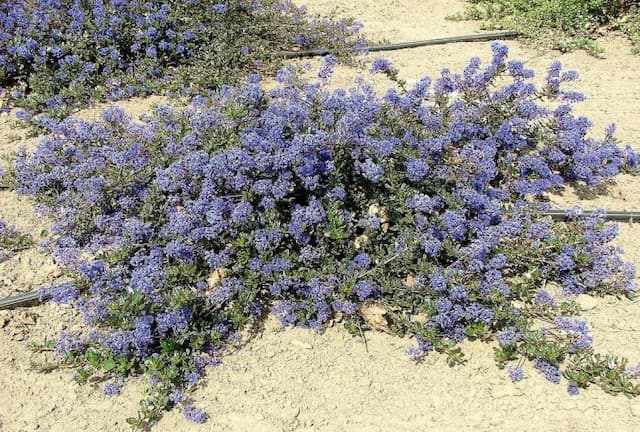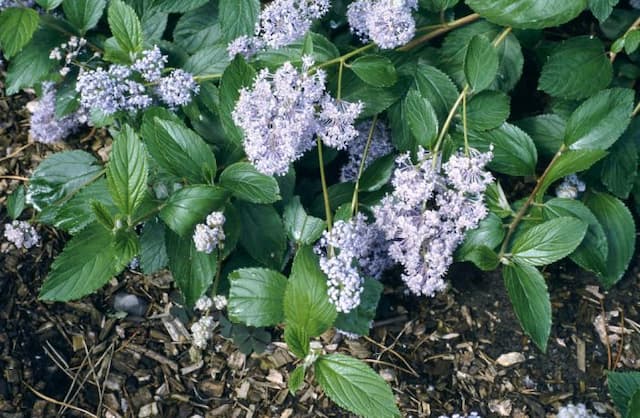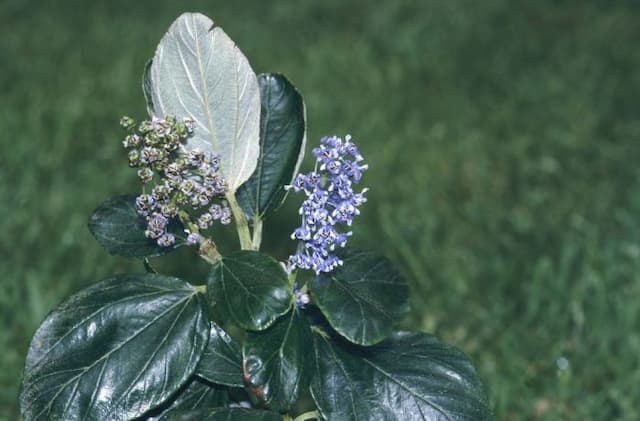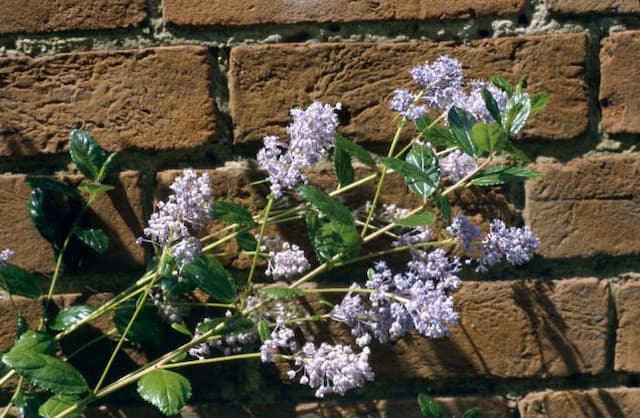Autumnal Blue Ceanothus × delileanus 'Topaze'

ABOUT
The Ceanothus × delileanus 'Topaze', commonly known as the Wild Lilac 'Topaze', has a striking appearance characterized by its lush foliage and vibrant flowers. Its leaves are small, glossy, and oval-shaped with a deep green color that provides a rich background for the plant's blossoms. The Wild Lilac 'Topaze' is best known for its abundant flower clusters that emerge in a radiant display of deep blue to purplish hues, creating a striking contrast against the foliage. The flowers are small but numerous, grouped together in dense, conical clusters known as panicles, which cover the shrub and add a splash of color to gardens when in bloom. The blooms are particularly attractive to various pollinators, including bees and butterflies, adding to the visual spectacle. The overall visual effect is one of a vibrant and textured mosaic of green and jewel-toned blue or purple, making it a popular choice for ornamental gardening and landscapes where its color can be fully appreciated without consideration of its dimensions.
About this plant
 Names
NamesFamily
Rhamnaceae
Synonyms
French Hybrid Ceanothus, Delile's Ceanothus
Common names
Ceanothus × delileanus 'Gloire de Versailles', Ceanothus × delilianus 'Gloire de Versailles'.
 Toxicity
ToxicityTo humans
The hybrid Ceanothus, commonly known as California Lilac, is not widely recognized for being toxic to humans. However, there is generally little information available about the toxicity of cultivars like Ceanothus × delileanus 'Topaze'. In the absence of specific data pointing to toxicity, it is always wise to exercise caution. If not known to be edible, it is best to avoid ingestion of any parts of ornamental plants. If ingestion occurs and any adverse reactions are observed, medical attention should be sought.
To pets
The California Lilac (Ceanothus × delileanus 'Topaze') is not commonly listed as toxic to pets. However, individual animals may have sensitivities or allergic reactions to plants that are not typically poisonous. Should a pet ingest part of a California Lilac and exhibit symptoms such as vomiting, diarrhea, or unusual behavior, it is important to contact a veterinarian for advice. Always err on the side of caution and keep an eye out for any signs of distress in pets after ingesting plant material, even those not known for toxicity.
 Characteristics
CharacteristicsLife cycle
Perennials
Foliage type
Evergreen
Color of leaves
Green
Flower color
Blue
Height
6 feet (1.83 meters)
Spread
6 feet (1.83 meters)
Plant type
Shrub
Hardiness zones
7
Native area
Hybrid
Benefits
 General Benefits
General Benefits- Attracts Wildlife: The Ceanothus × delileanus 'Topaze' is known to attract pollinators such as bees, butterflies, and birds, helping to support local ecosystems.
- Drought Tolerance: Once established, the 'Topaze' is very drought tolerant, making it an excellent choice for xeriscape gardens or arid environments.
- Low Maintenance: This plant requires minimal care once settled in its location, which is appealing for gardeners seeking low-maintenance landscaping options.
- Fast Growth: The 'Topaze' grows relatively quickly, providing a timely display of foliage and blooms in landscaping projects.
- Aesthetic Appeal: With its bright blue flowers and glossy green leaves, it adds vibrant color and visual interest to gardens and landscapes.
- Erosion Control: Its root system helps stabilize slopes and banks, making it beneficial for erosion control.
- Habitat Creation: It serves as a habitat for various species, offering shelter and food resources within its structure.
- Year-Round Interest: Due to its evergreen nature, it provides visual interest in the garden throughout the year.
 Medical Properties
Medical PropertiesThis plant is not used for medical purposes.
 Air-purifying Qualities
Air-purifying QualitiesThis plant is not specifically known for air purifying qualities.
 Other Uses
Other Uses- Ceanothus, with its rapid growth and dense foliage, can be trained as a living fence or privacy screen, effectively blocking unwanted views and defining property boundaries.
- The dense branches of Ceanothus make it suitable for creating windbreaks in coastal gardens, protecting more delicate plants from strong sea breezes.
- Because of its drought tolerance, Ceanothus × delileanus 'Gloire de Versailles' is used in xeriscaping, requiring minimal water once established and thus conserving water resources.
- The plant's vibrant blue flowers can be dried and used in decorative floral arrangements, retaining some color and adding a natural touch to interiors.
- Some species of Ceanothus are used as a food plant by the larvae of some butterfly species, providing a habitat and food source for these pollinators.
- Ceanothus wood, being hard and durable, has historically been used for making small items like tool handles, though this is not a common practice today.
- When planted on slopes, Ceanothus can help in erosion control due to its extensive root system, which holds the soil firmly in place.
- Due to its adaptability, it's used in reclaiming disturbed sites and urban land, helping in the process of ecological restoration by providing cover and improving soil quality.
- Gardeners can use this plant to add a burst of late spring to early summer color in perennial borders with its showy blue flowers.
- With its attractive form, Ceanothus can be used as a specimen plant, creating a focal point in a garden design with its shape and vibrant blooms.
Interesting Facts
 Feng Shui
Feng ShuiThe California lilac is not used in Feng Shui practice.
 Zodiac Sign Compitability
Zodiac Sign CompitabilityThe California lilac is not used in astrology practice.
 Plant Symbolism
Plant Symbolism- Endurance: Ceanothus species, also known as California lilac, display a strong resilience and an ability to thrive in tough conditions, symbolizing the power of endurance throughout life's challenges.
- Hope: The bright blossoms of the California lilac can signify hope, bringing a splash of color and optimism when they bloom in the spring.
- Patriotism: California lilac, being native to North America, can also represent patriotism, especially within the specific regions where it naturally grows.
- Renewal: The recurrent blooming of the California lilac symbolizes renewal and the cyclical nature of life, suggesting a rebirth or new beginnings with each season.
 Water
WaterFor the Californian Lilac, water it thoroughly once the top inch of soil feels dry, usually about once every week or two depending on the weather and the soil drainage. It's crucial not to overwater, as this plant prefers drier conditions once established. During the active growing season in spring and summer, water with about 1 gallon for smaller shrubs, and up to 2-3 gallons for larger ones ensuring moisture reaches the root zone. In the dormant season, reduce watering frequency to every two to three weeks or less, depending on the weather patterns and natural precipitation.
 Light
LightCalifornian Lilac thrives in full sun conditions, where they can receive at least six hours of direct sunlight daily. It's best to position this plant in a south-facing spot where it is exposed to plenty of natural light throughout the day. However, in extremely hot climates, some afternoon shade can be beneficial to prevent scorching of the leaves.
 Temperature
TemperatureCalifornian Lilac performs well in temperatures between 60 to 75 degrees Fahrenheit and can withstand minimum temperatures down to around 20 degrees Fahrenheit. Ideally, maintain an environment that avoids temperature extremes for optimal plant health. It can survive brief cold snaps but extended periods of freezing temperatures can be detrimental.
 Pruning
PruningPrune the Californian Lilac to maintain its shape and promote healthy growth, typically after the flowering period in late spring or early summer. Deadhead spent blooms to encourage reblooming and cut back about one-third of old growth to stimulate fresh shoots. Avoid heavy pruning, as this plant can be slow to recover from severe cuts. Pruning every year or every other year is generally sufficient.
 Cleaning
CleaningAs needed
 Soil
SoilThe Gloire de Versailles, or Ceanothus 'Topaze', prefers well-drained soil with added organic matter. A balanced mix of loam, peat, and coarse sand or perlite is ideal to ensure good drainage. Amend the soil with compost before planting to enrich it. The soil pH for Ceanothus 'Topaze' should be slightly acidic to neutral, between 5.5 and 7.5.
 Repotting
RepottingThe Gloire de Versailles, also known as Ceanothus 'Topaze', generally does not need frequent repotting and does well when left undisturbed. Repotting every 3-4 years or when the plant outgrows its container is sufficient. Always use fresh soil mix and a slightly larger pot to give the roots room to expand.
 Humidity & Misting
Humidity & MistingThe Ceanothus 'Topaze', commonly known as Gloire de Versailles, thrives best in moderate humidity levels. It does not require high humidity and can tolerate the dry air found in most homes. To ensure the best growth, maintain ambient humidity and avoid placing the plant in overly dry or draughty conditions.
 Suitable locations
Suitable locationsIndoor
Provide bright, indirect light and avoid overwatering.
Outdoor
Plant in sunny spot, shelter from strong winds, well-drained soil.
Hardiness zone
7-10 USDA
 Life cycle
Life cycleCeanothus × delileanus 'Topaze', commonly known as the Glossy Ceanothus, begins its life cycle as a seed, which requires well-draining soil and exposure to light for optimal germination. Once sprouted, the seedling grows rapidly, developing a deep root system and distinctive glossy green foliage. During spring to early summer, the plant enters its flowering stage, producing an abundance of bright blue to violet flowers that attract pollinators and beneficial insects. After pollination, the flowers develop into dry, dehiscent seed capsules, which eventually release seeds, completing the reproductive cycle. The Glossy Ceanothus reaches maturity in a few years and can live for a decade or more, during which time it may undergo periods of active growth and dormancy, often influenced by seasonal changes. Regular pruning during the active growth phase helps maintain the plant's bushy habit and stimulates new flowering shoots.
 Propogation
PropogationPropogation time
Spring-early summer
The California Lilac 'Topaze' can be propagated mainly by softwood cuttings taken in late spring or early summer when new growth is mature enough but still tender. To do this, cut a 4 to 6-inch (10 to 15 cm) length of stem with a sharp, sterilized blade, making sure that each cutting has at least two sets of leaves. Remove the leaves from the lower half of the cutting and dip the cut end into rooting hormone powder to encourage root development. Then, plant the cutting in a well-draining potting mix, water it well, and cover it with a plastic bag or place it in a propagator to retain humidity. In a few weeks, the cutting should start rooting, and once the roots are established, it can be transferred to a larger pot or planted outdoors.









